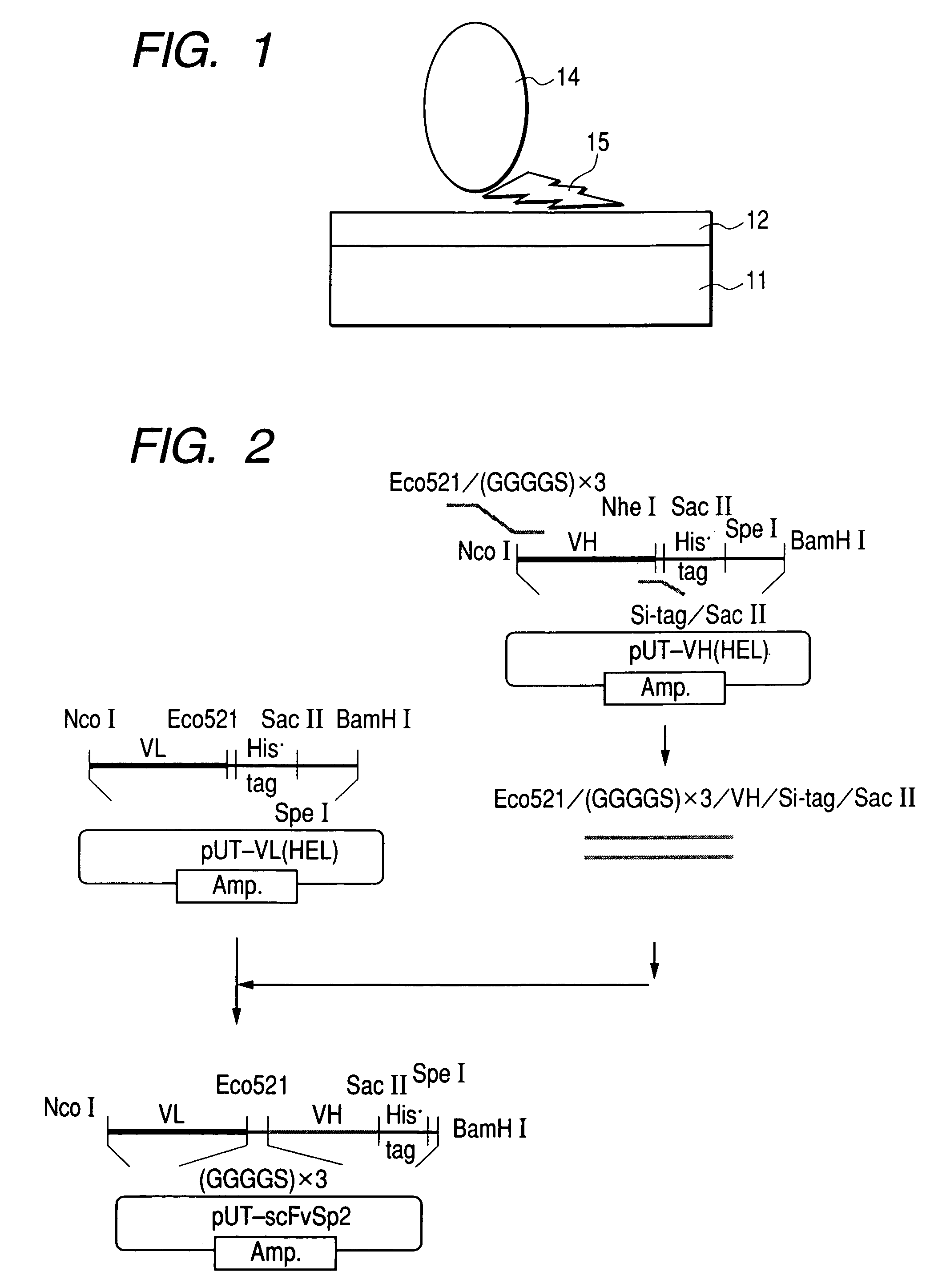Organic material-immobiling structure and method for production of the same, and peptide and DNA therefor
a technology of immobilizing structure and organic material, which is applied in the direction of depsipeptides, peptide/protein ingredients, unknown materials, etc., can solve the problems of excessive amount of biomaterials to be immobilized per day, detection sensitivity and reactivity matching the amount of immobilized biomaterials cannot be obtained
- Summary
- Abstract
- Description
- Claims
- Application Information
AI Technical Summary
Benefits of technology
Problems solved by technology
Method used
Image
Examples
reference example 1
Preparation of Mesoporous Silica (SBA-15)
[0099]A silica reaction solution consisting of 4 g of poly (ethylene oxide)-poly (propylene oxide)-poly (ethylene oxide) block copolymer comprised of 20 units of ethylene oxide, 70 units of propylene oxide and 20 units of ethylene oxide, hereinafter referred to as EO20-PO70-EO20, 0.041 mol tetraethoxy silane (TEOS), 0.24 mol HCl and 6.67 mol H2O was prepared.
[0100]This silica reaction solution was reacted at 35° C. for 20 hours, and then at 80° C. for 48 hours. Subsequently, the solution was heated at 500° C. for 6 hours to burn out the contained block copolymer EO20-PO70-EO20, whereby porous silica was obtained.
[0101]In the obtained porous silica, the average pore size was 7.9 nm, the average thickness of the silica wall between the pores was 3 nm.
reference example 2
Preparation of Transformant Having Capability of Producing PHA Synthetase, and Production of PHA Synthetase
[0102]A transformant having a capability of producing a PHA synthetase was prepared as follows.
[0103]First, Strain YN2 (Pseudomonas cichorii YN2, FERM BP-7375) having a capability of producing a PHA synthetase was cultured in 100 ml of LB culture medium (1% polypeptone, 0.5% yeast extract, 0.5% sodium chloride, pH 7.4) at 30° C. overnight, and then chromosomal DNA of the Strain YN2 was separated and collected by the method of Marmur, et al. The obtained chromosomal DNA was fully digested by a restriction enzyme HindIII. A cloning vector pUC18 was cleaved with the restriction enzyme HindIII. After terminal dephosphorylation (Molecular Cloning, 1, 572 (1989); Cold Spring Harbor Laboratory Press.), a DNA ligation kit Ver. II (Takara Shuzo Co., Ltd.) was used to insert / ligate the HindIII digested fragments of the chromosomal DNA into the cleaved site (cloning site) of the vector. W...
example 1
Acquirement of Amino Acid Sequence Having an affinity for Mesoporous Silica (SBA-15)
[0133](Step 1)
[0134]The mesoporous silica SBA-15 described in Reference Example 1 was suspended in a 0.1% Tween-20 / TBS buffer (50 mM Tris-HCl pH 7.5, 150 mM NaCl) (hereinafter referred to as TBST buffer) at a concentration of 5 mg / ml. 10 μl of the suspension was added to an Eppendorf tube, and 990 μl of TBST buffer (TBS buffer+0.1% Tween-20) was added to dilute the suspension.
[0135](Step 2)
[0136]4×1010 pfu equivalent of the PhD. −12 phage display peptide library (NEW ENGLAND BIOLAB) was added to the above-described tube, and left standing at 25° C. for 30 minutes.
[0137](Step 3)
[0138]The above-described tube was subjected to centrifugal separation (20, 630×g, 5 minutes), and then the supernatant was discarded to collect SBA-15 as a pellet. The pellet was re-suspended in TBST buffer. By repeating this operation of centrifugation and re-suspension, the SBA-15 was washed with the TBST buffer ten times.
[0...
PUM
| Property | Measurement | Unit |
|---|---|---|
| pore size | aaaaa | aaaaa |
| micropore size | aaaaa | aaaaa |
| micropore size | aaaaa | aaaaa |
Abstract
Description
Claims
Application Information
 Login to View More
Login to View More - R&D
- Intellectual Property
- Life Sciences
- Materials
- Tech Scout
- Unparalleled Data Quality
- Higher Quality Content
- 60% Fewer Hallucinations
Browse by: Latest US Patents, China's latest patents, Technical Efficacy Thesaurus, Application Domain, Technology Topic, Popular Technical Reports.
© 2025 PatSnap. All rights reserved.Legal|Privacy policy|Modern Slavery Act Transparency Statement|Sitemap|About US| Contact US: help@patsnap.com

